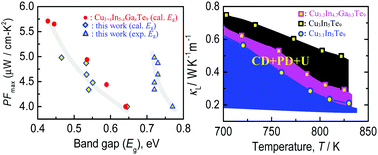Cation vacancy related crystal structure and bandgap and their effects on the thermoelectric performance of Cu-ternary systems Cu3+δIn5Te9 (δ = 0–0.175)†
Abstract
In this work the crystal structure and bandgap in the Cu3+δIn5Te9 material system were engineered through modifying the copper vacancy concentration (Vc). The results reveal that the crystal distortion parameter (ψ) increases as the Vc value decreases, which plays a fundamental role in enhancing the phonon scattering, thereby reducing the lattice part (κL) to the minimum value 0.21 W K−1 m−1 at ∼830 K. Although the electrical properties degrade due to the reduced Hall carrier concentration (nH) caused by the widened bandgap (Eg) as the Vc value increases, the mobility (μ) increases. As a consequence, the thermoelectric performance remarkably improves with a highest ZT value of ∼1.0 for the sample Cu3+δIn5Te9 (δ = 0.1). This value doubles that of the pristine Cu3In5Te9. The work gives insight into the potential phonon scattering in the distorted crystal structure in Cu-ternary systems and sheds some light on the design of high performance thermoelectric materials.



 Please wait while we load your content...
Please wait while we load your content...